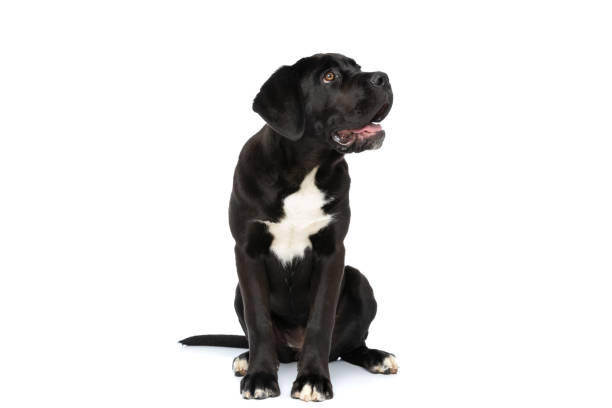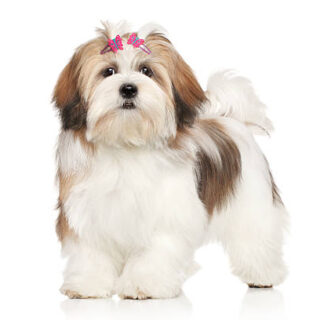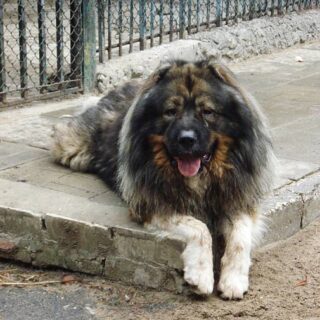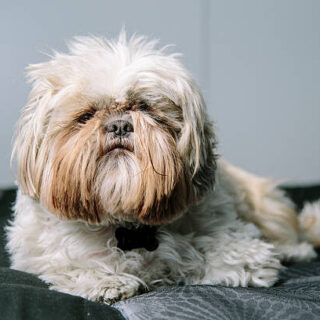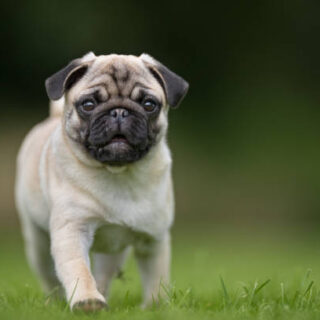Cane Corso
Cane Corso (Corso for short) is a serious dog breed for a person who is serious about having a dog as a companion and who can provide him with the firm and loving guidance he needs to become a great dog. He is a family-only dog. Dont expect him to buddy up with everyone he meets: He has no interest in people or other animals outside his family, but those within the family will have his undivided loyalty and protection.
-
Highlights
- The Corsos short coat comes in black, light, and dark shades of gray; light and dark shades of fawn; and red. Any of these colors may have a brindle pattern: irregular streaks of light and dark color.
- Solid fawn and red Corsos may have a black or gray mask.
- The Corsos ears may be cropped or uncropped.
- The Corso is a working dog who needs lots of mental and physical stimulation.
- Corsos are not demonstrative, but they enjoy talking to their people with woo woo woo sounds, snorts, and other verbalizations.
- The Corso is not a good first dog. He requires plenty of socialization, training, and exercise to be a good companion.
-
History
The Corso is one of many Mastiff-type dogs. This one was developed in Italy and is said to descend from Roman war dogs. He is more lightly built than his cousin, the Neapolitan Mastiff, and was bred to hunt game, guard property, and be an all-around farm hand. Their work included rounding up pigs or cattle and helping to drive them to market.
The word cane, of course, is Latin for dog and derives from the word canis. The word corso may come from cohors, meaning bodyguard, or from corsus, an old Italian word meaning sturdy or robust.
The breed declined as farming became more mechanized and came near to extinction, but starting in the 1970s dog fanciers worked to rebuild the Corso. The Society Amatori Cane Corso was formed in 1983, and the Federation Cynologique Internationale recognized the breed in 1996.
A man named Michael Sottile imported the first litter of Corsos to the United States in 1988, followed by a second litter in 1989. The International Cane Corso Association was formed in 1993. Eventually, the breed club sought recognition from the American Kennel Club, which was granted in 2010. The breed is now governed by the Cane Corso Association of America.
-
Size
The Corso is a large, muscular dog. Males stand 25 to 27.5 inches at the withers; females 23.5 to 26 inches. Weight is proportionate to height and typically ranges from 90 to 120 pounds.
-
Health
Corsos are generally healthy, but like all breeds, theyre prone to certain health conditions. Not all Corsos will get any or all of these diseases, but its important to be aware of them if youre considering this breed.
The Corso can be prone to hip dysplasia; eyelid abnormalities such as entropion, ectropion, and cherry eye; demodectic mange (which can be heritable); and gastric torsion, also known as bloat.
Expect breeders to have up-to-date health clearances certifying that a puppys parents are free of eye disease and hip dysplasia. Clearances should be in the form of an eye exam by a board-certified veterinary ophthalmologist with the results registered with the Orthopedic Foundation for Animals and an OFA or Pennhip evaluation of the hips. You can confirm health clearances by checking the website of the Canine Health Information Center. You should also ask if any of the breeders dogs have ever suffered bloat or mange.
Regardless of how healthy your dog is when you first bring them home, you should prepare for any issues that may come up throughout their life.
-
Care
This working breed needs plenty of physical activity to stay in shape. Plan on taking him for a brisk walk or jog of at least a mile, morning and evening, every day. If you like to bicycle, get an attachment that will allow him to run alongside you.
Go easy on puppies. Their musculoskeletal system isnt fully developed until they are about 18 months old, so while they need more walks to help burn off their puppy energy, those walks should be shorter and slower.
For mental stimulation, provide this dog with a job. Good employment for a Corso includes herding livestock (your own or a trainers), learning tricks, practicing obedience skills, or being involved in a dog sport. Spend at least 20 minutes a day on these types of activities. Its okay to break it up: for instance, 10 minutes in the morning and 10 minutes in the evening.
Never allow a Corso to run loose. A solid, secure fence is a must. An electronic fence will not prevent him from leaving your property if he chooses to, and it wont protect your neighbors dog or cat if he wanders into your yard.
Finally, be prepared for the amount of care and large bills that can go along with owning a large dog. Theres more poop to scoop, and essentials such as spay/neuter surgery are more expensive for big dogs than for small ones. If your Corso needs surgery for any other reason, the cost of anesthesia will be high because he needs more of it than a small dog, as well as larger amounts of pain medication after surgery. Finally, there are the costs of training class, entry fees for dog sports, and pet-sitting or boarding when you are away from home. Take all of these expenses into consideration before acquiring a Corso because you will be facing them for 10 to 12 years.
Feeding
Recommended daily amount: If you are feeding a high-quality dry food, your Corso will probably eat 4 to 5 cups a day.
Note: How much your adult dog eats depends on his size, age, build, metabolism, and activity level. Dogs are individuals, just like people, and they don’t all need the same amount of food. It almost goes without saying that a highly active dog will need more than a couch potato dog. The quality of dog food you buy also makes a difference the better the dog food, the further it will go toward nourishing your dog and the less of it you’ll need to shake into your dog’s bowl.
Keep your Corso in good shape by measuring his food and feeding him twice a day rather than leaving food out all the time. If you’re unsure whether he’s overweight, give him the eye test and the hands-on test.
First, look down at him. You should be able to see a waist. Then place your hands on his back, thumbs along the spine, with the fingers spread downward. You should be able to feel but not see his ribs without having to press hard. If you can’t, he needs less food and more exercise.
For more on feeding your Corso, see our guidelines for buying the right food, feeding your puppy, and feeding your adult dog.
-
Coat Color And Grooming
The Corso has a short, stiff coat with a light undercoat. It can be black, gray, red or fawn and may or may not have a brindle pattern. The coat sheds heavily twice a year, so have a good vacuum cleaner on hand to suck up the dust bunnies.
If you plan to bathe your Corso on a regular basis, accustom him to the experience at an early age. Bathe him weekly as a young pup, teaching him the command Bath, so that he learns to expect and accept it. Give him plenty of praise and rewards to sweeten the deal.
Brush your Cane Corsos teeth at least two or three times a week to remove tartar buildup and the bacteria that lurk inside it. Daily brushing is even better if you want to prevent gum disease and bad breath.
To prevent painful tears and other problems, trim his nails once or twice a month if your dog doesn’t wear them down naturally. If you can hear them clicking on the floor, they’re too long. Dog toenails have blood vessels in them, and if you cut too far you can cause bleeding and your dog may not cooperate the next time he sees the nail clippers come out. So, if you’re not experienced at trimming dog nails, ask a vet or groomer for pointers.
Check ears weekly for redness or a bad odor, which can indicate an infection. When you check your dog’s ears, wipe them out with a cotton ball dampened with gentle, pH-balanced ear cleaner to help prevent infections. Don’t insert anything into the ear canal; just clean the outer ear.
Begin accustoming your Corso to being brushed and examined when he’s a puppy. Handle his paws frequently dogs are touchy about their feet and look inside his mouth. Make grooming a positive experience filled with praise and rewards, and you’ll lay the groundwork for easy veterinary exams and other handling when he’s an adult.
As you groom, check for sores, rashes, or signs of infection such as redness, tenderness, or inflammation on the skin, in the nose, mouth, and eyes, and on the feet. Eyes should be clear, with no redness or discharge. Your careful weekly exam will help you spot potential health problems early.
-
Children And Other Pets
When he is properly raised, trained, and socialized, the Corso can be loving toward and protective of children. Its important, however, that puppies and adult dogs not be given any opportunity to chase children and that kids avoid making high-pitched sounds in his presence. Running and squealing may cause the Corso to associate children with prey. Keep him confined when kids are running around outdoors and making lots of noise, especially if your children have friends over. The Corso may think it necessary to step in and protect his kids, and that is unlikely to end well.
Related products
-
Lhasa Apso
Read moreLhasa Apso Lhasa Apso is a small, well-muscled hardy little house dog originating in Tibet and is thought to be descended from the type of dog common for centuries over Central Asia. The name Apso is used in Tibet for both of their smaller longhaired breeds and means longhaired or goat like. Average lifespan Lhasas …
-
Caucasian Shepherd
Read moreCaucasian Shepherd The Caucasian Shepherd Dog is a loyal guardian to the core. Bred to help shepherds in the Caucasus Mountain region keep their flocks safe from predators like wolves and bears. They often use these instincts in modern times to act as watchdogs and protectors, though they are sometimes overly apprehensive around strangers. Don’t …
-
Shih Tzu Dog Breed
Read moreShih Tzu Dog Breed Shih Tzu dogs are of Asian origin, specifically from Tibet. They were offered as gifts to the Chinese royalty. Big round eyes, floppy ears, a short snout, and an extra hairy coat are some of the reasons why people love Shih Tzu dogs. Their friendly and playful nature makes Shih Tzus …
-
Pug dog breed
Read morePug Pug is among the most popular dog breeds in the world. They fall into the small dog breed category and are more commonly identified as lap dogs as they can easily fit in your lap and love snuggling you. Pugs make for great first time pets and are through and through family dogs. Their …

